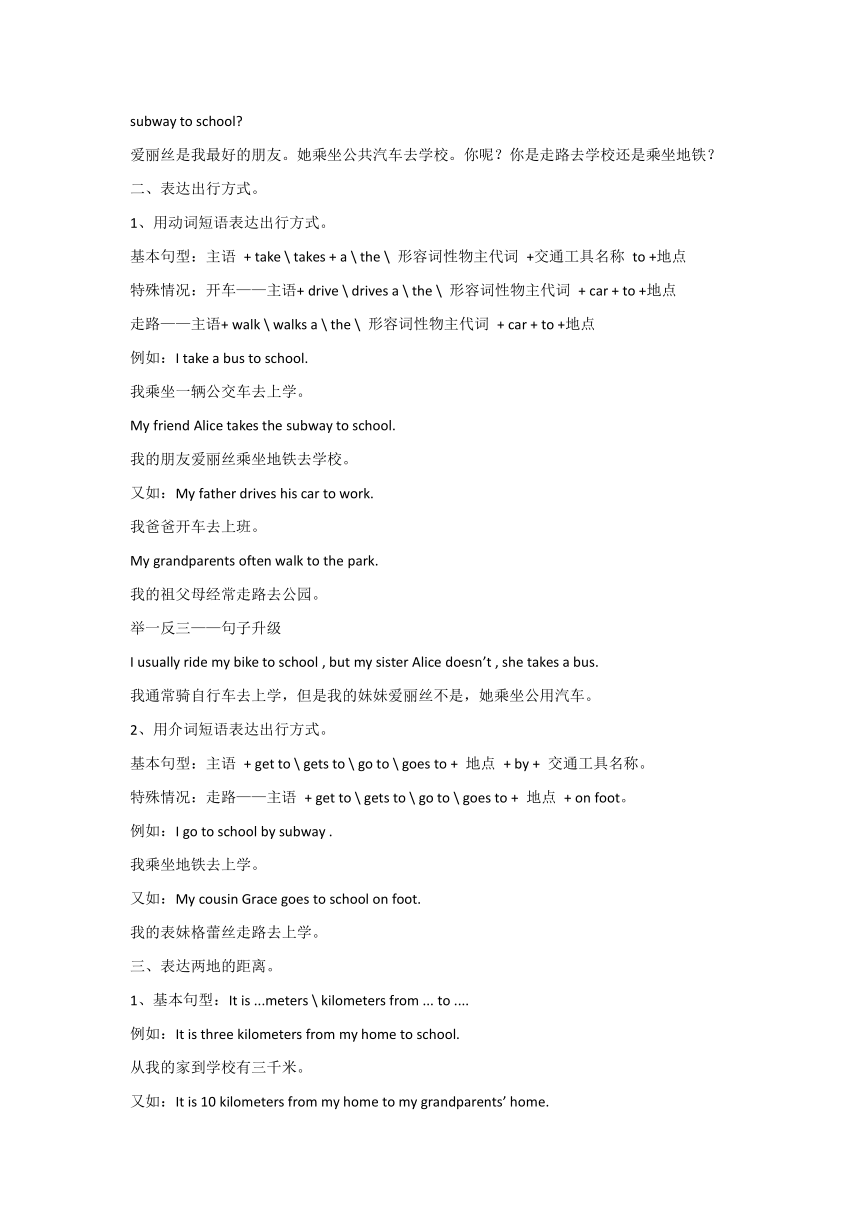人教版英语七年级下册Unit 3 How do you get to school?书面表达重点突破
文档属性
| 名称 | 人教版英语七年级下册Unit 3 How do you get to school?书面表达重点突破 |  | |
| 格式 | docx | ||
| 文件大小 | 15.3KB | ||
| 资源类型 | 教案 | ||
| 版本资源 | 人教新目标(Go for it)版 | ||
| 科目 | 英语 | ||
| 更新时间 | 2024-05-21 06:02:39 | ||
图片预览


文档简介
人教版英语七年级下册第三单元单元书面表达重点突破
书面表达是围绕一定话题来展开的。人教版英语七年级下册第三单Unit 3 How do you get to school 主要通过谈论怎样出行(出行方式),引出与之相关的书面表达的内容,接下来我们就来一一总结。
本单元牵涉到的书面表达的一些句子:
询问出行方式。
特殊疑问句,询问出行方式。
例如:How do you get to school
你怎样去学校?
又如:How does your best friend Alice get to school
你最好的朋友爱丽丝怎样去学校?
举一反三——句子升级
Different students have different ways to school. How do you go to school and how does your sister go go to school
不同的学生有不同的上学方式。你怎样上学?你的妹妹怎样上学?
一般疑问句,询问出行方式。
例如:Do you walk to school
你走路上学吗?
又如:Does your cousin Tom take a bus to school
你的表兄汤姆是乘公共汽车去上学吗?
举一反三——句子升级
I walk to school every day. How about you Do you take a bus to school
我走路去学校。你呢?你是乘坐公用汽车上学吗?
选择疑问句询问出行方式。
例如:Do you walk or ride a bike to school
你是走路还是骑自行车上学?
又如:Do you go to school by bus or by train
你是乘坐公共汽车还是乘坐火车去上学?
举一反三——句子升级
Alice is my best friend. She takes a bus to school. How about you Do you walk to school or take a subway to school
爱丽丝是我最好的朋友。她乘坐公共汽车去学校。你呢?你是走路去学校还是乘坐地铁?
表达出行方式。
用动词短语表达出行方式。
基本句型:主语 + take \ takes + a \ the \ 形容词性物主代词 +交通工具名称 to +地点
特殊情况:开车——主语+ drive \ drives a \ the \ 形容词性物主代词 + car + to +地点
走路——主语+ walk \ walks a \ the \ 形容词性物主代词 + car + to +地点
例如:I take a bus to school.
我乘坐一辆公交车去上学。
My friend Alice takes the subway to school.
我的朋友爱丽丝乘坐地铁去学校。
又如:My father drives his car to work.
我爸爸开车去上班。
My grandparents often walk to the park.
我的祖父母经常走路去公园。
举一反三——句子升级
I usually ride my bike to school , but my sister Alice doesn’t , she takes a bus.
我通常骑自行车去上学,但是我的妹妹爱丽丝不是,她乘坐公用汽车。
用介词短语表达出行方式。
基本句型:主语 + get to \ gets to \ go to \ goes to + 地点 + by + 交通工具名称。
特殊情况:走路——主语 + get to \ gets to \ go to \ goes to + 地点 + on foot。
例如:I go to school by subway .
我乘坐地铁去上学。
又如:My cousin Grace goes to school on foot.
我的表妹格蕾丝走路去上学。
表达两地的距离。
1、基本句型:It is ...meters \ kilometers from ... to ....
例如:It is three kilometers from my home to school.
从我的家到学校有三千米。
又如:It is 10 kilometers from my home to my grandparents’ home.
从我的家到祖父母的家有10千米远。
2、基本句型:It is (not) far from...
离...(不)远。
例如:Look at my house , it’s over there and it’s not far from school.
看,那边就是我的家,它离学校不远。
表达乘坐某个交通工具到某地要花费的时间。
基本句型:It takes sb. some time to do sth.
例如:It takes me ten minutes to take a bus to school.
乘坐公共汽车到学校花费了我十分钟(的时间)。
举一反三——句子升级
例如:It is far from my home to school and it takes me half an hour to take a subway to school.
我的家离学校比较远,我乘坐地铁去学校花费了半个小时。
又如:As a student in Grade 9 , I am busy every day and it takes me two hours to finish my homework. 作为一个九年级(初三)的学生,我每天都很忙,完成作业要花费两个小时的时间。
句型:It’s + adj.(形容词)for sb. to do sth.
对于某人来说,做某事是...的。
例如:It’s easy for me to take a bus to school.
对我来说,乘坐公共汽车去上学是容易的。
本单元常见书面表达:
根据提示,描述你(Alice)以及你的朋友Jim 和Helen上学情况。
Alice:walk to school ; 1 kilometer from school
Jim :ride a bike to school ; three kilometers ; 10 minutes
Helen :take a bus to school ; five kilometers ; 12 minutes
参考范文:
Different people have different ways to school. I am Alice and I walk to school because my home
is not far from school. It is only one kilometer.
This is my friend Jim , it is three kilometers from his home to school. So he usually rides a bike
to school. it takes him about ten minutes
Helen is also my friend .It is five kilometers from her home to school , so she often takes a bus to
school . It takes her about twelve minutes.
同学们,以上就是人教版英语七年级下册第三单Unit 3 How do you get to school 书面表达中会用到的一些句子,希望对你们有所帮助。
书面表达是围绕一定话题来展开的。人教版英语七年级下册第三单Unit 3 How do you get to school 主要通过谈论怎样出行(出行方式),引出与之相关的书面表达的内容,接下来我们就来一一总结。
本单元牵涉到的书面表达的一些句子:
询问出行方式。
特殊疑问句,询问出行方式。
例如:How do you get to school
你怎样去学校?
又如:How does your best friend Alice get to school
你最好的朋友爱丽丝怎样去学校?
举一反三——句子升级
Different students have different ways to school. How do you go to school and how does your sister go go to school
不同的学生有不同的上学方式。你怎样上学?你的妹妹怎样上学?
一般疑问句,询问出行方式。
例如:Do you walk to school
你走路上学吗?
又如:Does your cousin Tom take a bus to school
你的表兄汤姆是乘公共汽车去上学吗?
举一反三——句子升级
I walk to school every day. How about you Do you take a bus to school
我走路去学校。你呢?你是乘坐公用汽车上学吗?
选择疑问句询问出行方式。
例如:Do you walk or ride a bike to school
你是走路还是骑自行车上学?
又如:Do you go to school by bus or by train
你是乘坐公共汽车还是乘坐火车去上学?
举一反三——句子升级
Alice is my best friend. She takes a bus to school. How about you Do you walk to school or take a subway to school
爱丽丝是我最好的朋友。她乘坐公共汽车去学校。你呢?你是走路去学校还是乘坐地铁?
表达出行方式。
用动词短语表达出行方式。
基本句型:主语 + take \ takes + a \ the \ 形容词性物主代词 +交通工具名称 to +地点
特殊情况:开车——主语+ drive \ drives a \ the \ 形容词性物主代词 + car + to +地点
走路——主语+ walk \ walks a \ the \ 形容词性物主代词 + car + to +地点
例如:I take a bus to school.
我乘坐一辆公交车去上学。
My friend Alice takes the subway to school.
我的朋友爱丽丝乘坐地铁去学校。
又如:My father drives his car to work.
我爸爸开车去上班。
My grandparents often walk to the park.
我的祖父母经常走路去公园。
举一反三——句子升级
I usually ride my bike to school , but my sister Alice doesn’t , she takes a bus.
我通常骑自行车去上学,但是我的妹妹爱丽丝不是,她乘坐公用汽车。
用介词短语表达出行方式。
基本句型:主语 + get to \ gets to \ go to \ goes to + 地点 + by + 交通工具名称。
特殊情况:走路——主语 + get to \ gets to \ go to \ goes to + 地点 + on foot。
例如:I go to school by subway .
我乘坐地铁去上学。
又如:My cousin Grace goes to school on foot.
我的表妹格蕾丝走路去上学。
表达两地的距离。
1、基本句型:It is ...meters \ kilometers from ... to ....
例如:It is three kilometers from my home to school.
从我的家到学校有三千米。
又如:It is 10 kilometers from my home to my grandparents’ home.
从我的家到祖父母的家有10千米远。
2、基本句型:It is (not) far from...
离...(不)远。
例如:Look at my house , it’s over there and it’s not far from school.
看,那边就是我的家,它离学校不远。
表达乘坐某个交通工具到某地要花费的时间。
基本句型:It takes sb. some time to do sth.
例如:It takes me ten minutes to take a bus to school.
乘坐公共汽车到学校花费了我十分钟(的时间)。
举一反三——句子升级
例如:It is far from my home to school and it takes me half an hour to take a subway to school.
我的家离学校比较远,我乘坐地铁去学校花费了半个小时。
又如:As a student in Grade 9 , I am busy every day and it takes me two hours to finish my homework. 作为一个九年级(初三)的学生,我每天都很忙,完成作业要花费两个小时的时间。
句型:It’s + adj.(形容词)for sb. to do sth.
对于某人来说,做某事是...的。
例如:It’s easy for me to take a bus to school.
对我来说,乘坐公共汽车去上学是容易的。
本单元常见书面表达:
根据提示,描述你(Alice)以及你的朋友Jim 和Helen上学情况。
Alice:walk to school ; 1 kilometer from school
Jim :ride a bike to school ; three kilometers ; 10 minutes
Helen :take a bus to school ; five kilometers ; 12 minutes
参考范文:
Different people have different ways to school. I am Alice and I walk to school because my home
is not far from school. It is only one kilometer.
This is my friend Jim , it is three kilometers from his home to school. So he usually rides a bike
to school. it takes him about ten minutes
Helen is also my friend .It is five kilometers from her home to school , so she often takes a bus to
school . It takes her about twelve minutes.
同学们,以上就是人教版英语七年级下册第三单Unit 3 How do you get to school 书面表达中会用到的一些句子,希望对你们有所帮助。
同课章节目录
- Unit 1 Can you play the guitar?
- Section A
- Section B
- Unit 2 What time do you go to school?
- Section A
- Section B
- Unit 3 How do you get to school?
- Section A
- Section B
- Unit 4 Don't eat in class.
- Section A
- Section B
- Unit 5 Why do you like pandas?
- Section A
- Section B
- Unit 6 I'm watching TV.
- Section A
- Section B
- Review of Units 1-6
- Unit 7 It's raining!
- Section A
- Section B
- Unit 8 Is there a post office near here?
- Section A
- Section B
- Unit 9 What does he look like?
- Section A
- Section B
- Unit 10 I'd like some noodles.
- Section A
- Section B
- Unit 11 How was your school trip?
- Section A
- Section B
- Unit 12 What did you do last weekend?
- Section A
- Section B
